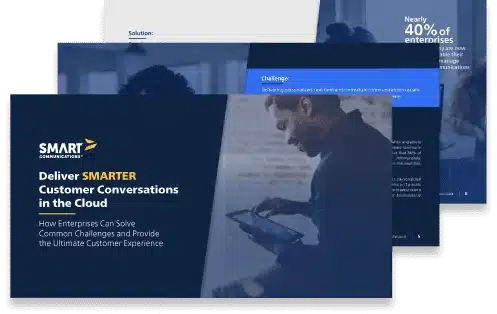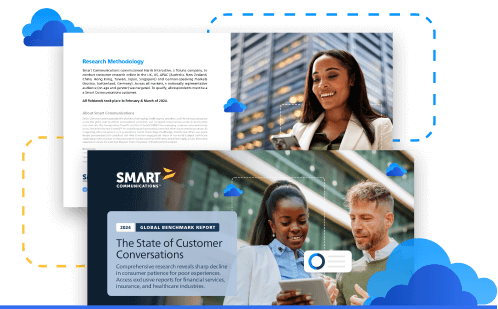Healthcare Member Communications Are Ripe for Transformation – Are You Prepared?
By: John Zimmerer, VP of Industry Marketing, Insurance at Smart Communications
As parts of the world begin to open up, it’s easy to think that life, for both businesses and consumers, can simply pick up where we left off. But to do so would ignore the opportunities for improvement that we were forced to explore during the worst of the pandemic. One key lesson at the top of our list? The need for healthcare payers and providers to focus on timely, relevant and personalized member communications. While the pandemic provided the catalyst to accelerate the implementation of better digital conversation experiences, there’s still a long way to go, as revealed by data from J.D. Power:
- 54% of members do not understand if telehealth services are covered
- 48% believe the payer has not shown concern for their health since the pandemic began
- Only 25% view the payer as their trusted partner
- Only 36% feel the payer acts in their best interest
Clearly, there are major gaps in the way healthcare payers and providers think they are communicating to members, and how members are actually receiving those messages. In fact, recent research revealed that 63% of businesses think they are delivering excellent or very good communications to their customers, but only 51% of consumers give the same ratings to the communications they receive.
In a recent panel discussion at the Cognizant Healthcare Conference, three Smart Communications experts shared their perspectives on how the healthcare communications landscape is changing, and what leading payers and providers need to do to transform member experiences. While we invite you to view the full recording below, this post also highlights some of the key takeaways from the discussion and some best practices for delivering two-way, digital conversations.
Key Challenges Accelerating the Pace of Communication Transformation
The J.D. Power statistics show us that trust is low, and key messages, like those around telehealth coverage, are being missed or fall flat. Historically, this has been caused by both technological and operational limitations:
- Static, mass email blasts to all customers delivering the same high-level messaging regardless of individual circumstances
- Disconnected communication experiences that force members to provide the same information again and again across channels
- An over-reliance on print for communicating key messages instead of a multichannel approach based on a customer’s stated preferences
These challenges have been felt across the four key areas of the healthcare member experience where it is most important to get communications right: member acquisition and enrollment, onboarding, care management and claims. If customers feel like they’re having suboptimal experiences everywhere they turn, it’s no wonder their frustration results in lower scores on the most critical customer satisfaction metrics.
Creating SMARTER Member Conversations
The good news is that many of these challenges can be solved. Leading payers and providers are taking the steps necessary to overcome traditional challenges and build the technical and operational infrastructure needed to transform the future of healthcare communications.
One powerful example of how to achieve the dream state of SMARTER customer conversations comes from Blue Shield of California, as shared at INNOVATE 2021. In their quest for 95% of communications to be digital-first, they pursued the following principles for success:
- Make it Simple – only deliver communications that solve or pre-empt members’ needs and expectations. Rely on dynamic templates that drive consistency across channels but also increase agility. Then, streamline preview and approval processes.
- Make it Useful – only deliver communications that provide relevant information in every channel, based on a combination of stated preferences and insights derived from advanced analytics.
- Make it Mine – only deliver communications that are personalized, while keeping security top of mind.
These guiding principles are an important starting point for the larger question healthcare payers and providers are focused on – where are the biggest opportunities for improvement?
Here are just a few examples of how digital optimization can make a huge impact, along with real-world results:
Collecting Open Enrollment Choices Digitally
As the largest customer-owned health insurer in the U.S., supporting 140,000 employers across 5 states, Health Care Service Corporation (HCSC) realized the importance of transforming its open enrollment processes. HCSC had 250 manual, static forms which contained 20 unique sections with 3,000 different attributes that needed to be delivered to 26 downstream internal and external customers. The need for a highly scalable solution was especially evident here. HCSC worked with Smart Communications to eliminate manual forms in favor of a single, guided, digital interview process.
Using SmartIQTM, HCSC eliminated manual re-entry, reduced their support team training time and increased the amount of time employers had to make decisions, ultimately increasing productivity while lowering cost. Learn more about HCSC’s success in Transforming Manual Forms Processes into Exceptional Digital Experiences from INNOVATE 2021.
Streamline the Contract Generation Process
A leading managed healthcare and insurance provider sought to digitally optimize and improve their employer-sponsored plans. By working with Smart Communications, they managed to optimize a manual contract generation process involving multiple internal and external groups that took 2 weeks to just 1 business day—a 90% increase in efficiency. Additionally, when used in combination with SmartCOMMTM for Salesforce, they were able to generate a contract in only 30 minutes, a dramatic improvement from where they were.
Globalization and Optimization Across the Enterprise – at Scale
The ability to optimize across multiple brands, jurisdictions and languages can vastly improve efficiency while reducing cost. By leveraging approachable technology, payers and providers can also optimize their workload throughout the organization, instead of being in a situation where certain tasks can only be completed by IT or specific subject matter experts.
With healthcare communications at an inflection point, taking proactive steps to align technology and operations for an optimal member experience is essential. And the cascading business benefits are measurable.
If you’d like to learn more about transforming healthcare member communications, check out our white paper “From Onboarding to Lifelong Relationships.”



